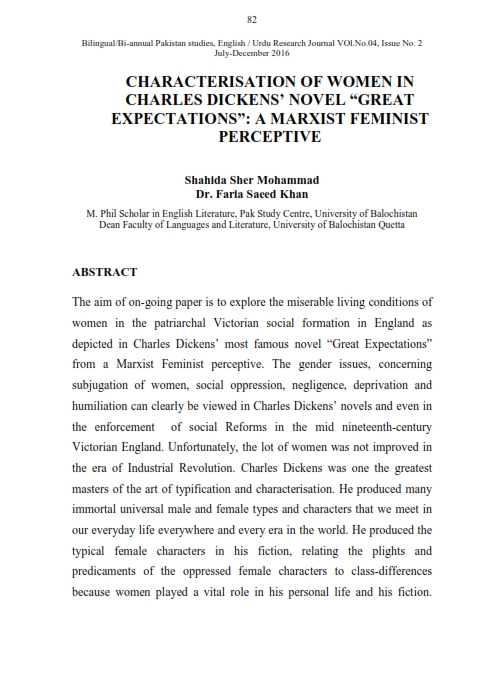CHARACTERISATION OF WOMEN IN CHARLES DICKENS’ NOVEL “GREAT EXPECTATIONS A MARXIST FEMINIST PERCEPTIVE
Keywords:
Patriarchy, Male dominancy, Class-differences, Industrial Revolution, Gender discrimination.Abstract
The aim of on-going paper is to explore the miserable living conditions of
women in the patriarchal Victorian social formation in England as
depicted in Charles Dickens’ most famous novel “Great Expectations”
from a Marxist Feminist perceptive. The gender issues, concerning
subjugation of women, social oppression, negligence, deprivation and
humiliation can clearly be viewed in Charles Dickens’ novels and even in
the enforcement of social Reforms in the mid nineteenth-century
Victorian England. Unfortunately, the lot of women was not improved in
the era of Industrial Revolution. Charles Dickens was one the greatest
masters of the art of typification and characterisation. He produced many
immortal universal male and female types and characters that we meet in
our everyday life everywhere and every era in the world. He produced the
typical female characters in his fiction, relating the plights and
predicaments of the oppressed female characters to class-differences
because women played a vital role in his personal life and his fiction.
Drawing upon his personal feelings, observations and experiences of the
miseries and hardships of these oppressed female figures, he realistically
challenged the patriarchal values and traditions of the bourgeois
patriarchal Victorian social formation, raising the status of them in his
novels.
References
Abrahams, M. H. (1993). The Norton Anthology of English
Literature, Vol. II, 6th Edition. New York: W.W. Norton.
Ackroyd, P. (2002). Dickens: A Biography. London: SinclairStevenson.
Ayres, B.(1998).“Dissenting Women in Dickens’ Novels: The
Subversion of Domestic Ideology. West Port: Greenwood Press.
Dickens, C. (1988). Great Expectations. London: Longman.
Dickens, C. (2000). Little Dorrit. New York: Everyman’s Library.
Forster, J. (1928). Life of Charles Dickens. (3 Volumes, 1872-4.
(ed.), J. W. T. Ley. New York: Doubleday.
Hawes, D. (1998). Who’s Who in Dickens. London: Routledge.
http://www.un.org/africarenewal/magazine/july-2005/africanwomen-battle-equality
http://www.afdb.org/fileadmin/uploads/afdb/Documents/Knowledg
e/25040341-FR-DRAFT-DEJENE.9-15-07DOC.PDF
Johnson, E. (1977). Charles Dickens: His Tragedy and Triumph.
London: Allen Lane.
Johnston, J.(1992). “Women and Violence in Dickens’ Great
Expectations”. In: Vol.18. Pp.93-110.
Keating P.J. (1971). The working Class in Victorian Fiction.
London: Routledge.
Koumakpaï, T. and Towa-Sello, K. J. (2016) “Exploring Women’s
Identity in Selected Charles Dickens’s Works: A Re-visitation
from a Contemporary African Perspective”. In: International
Journal on Studies in English Language and Literature (IJSELL)
Volume 4, Issue 6, June 2016, PP 85-95 ISSN 2347-3126 (Print) &
ISSN 2347-3134 (Online)
http://dx.doi.org/10.20431/2347-3134.0406012
www.arcjournals.org.
Margolyes, M. and Fraser, S. (2012). Dickens’ women. New
York: Hesperus Press.
Pickrel, P. (1960). “Teaching the Novel: Great Expectation”. In:
Essays in the teaching of English: Reports of the Yale Conferences
on the Teaching of English, ed. Edward J. Gordon and Edward S.
Noyes. New York: Appleton-century Crofts, Ink.
Saxena, S. (2013). “Shifting women from periphery to the Centre:
A Feminist Study of Charles Dickens’ Great Expectations”. In:
IRWLE Vol. 9 No.1.Pp.1-6.
Toyne, A. (1971). An English-Reader’s History of England,
London: Oxford University Press.
Wittig, M. (1979). “One Is Not Born a Woman”, text of the speech
given at the City University of New York Graduate Centre.
September 1979.



